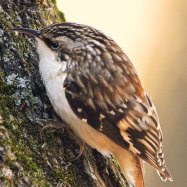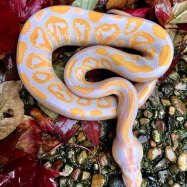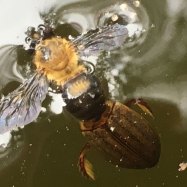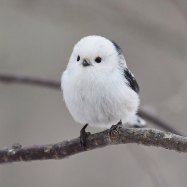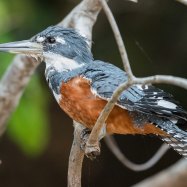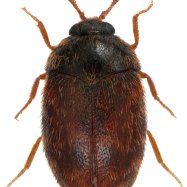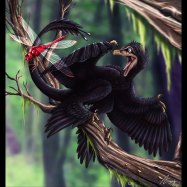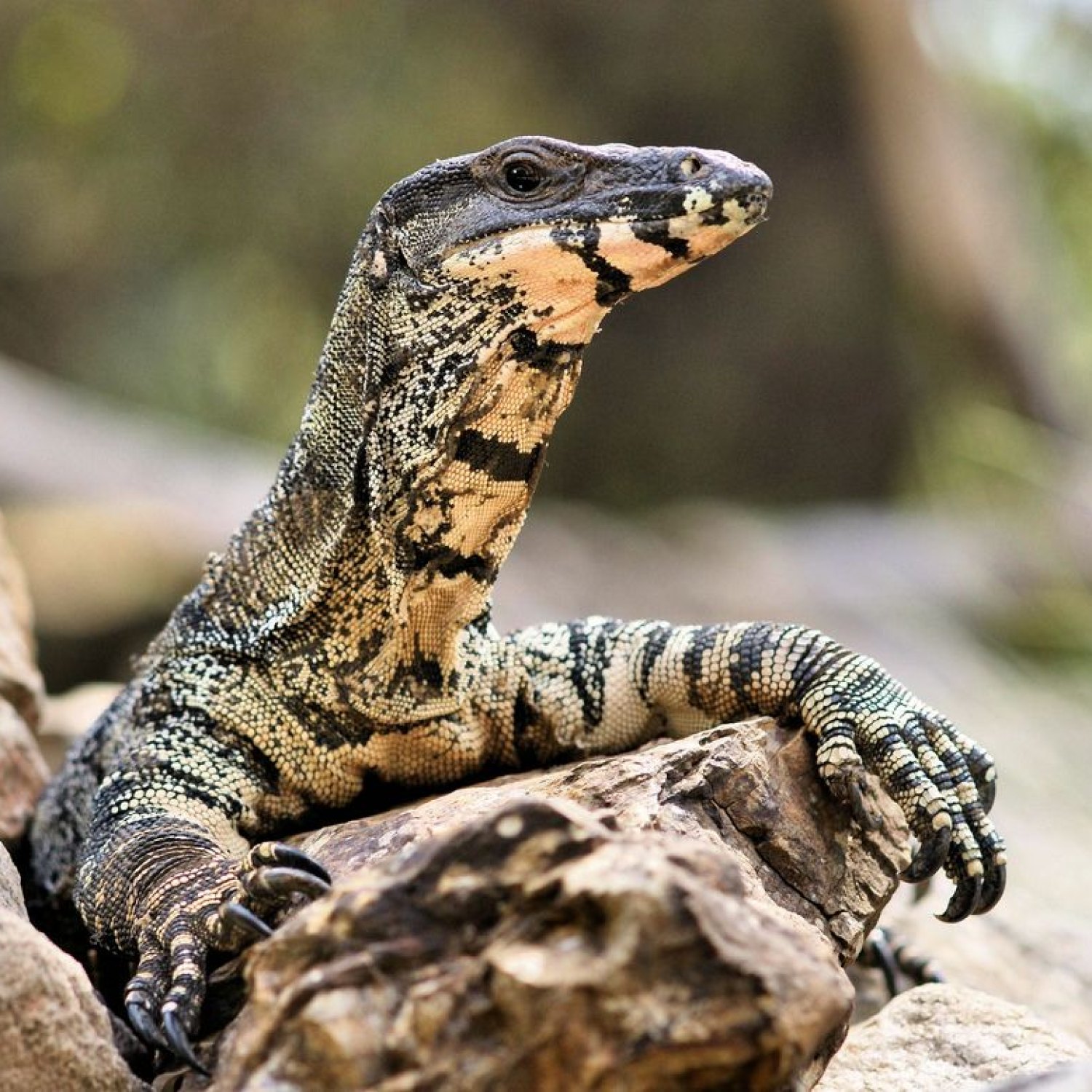
Lace Monitor
1.5-2 meters
The Lace Monitor, also known as Lace Goanna, is a fascinating reptile found in Eastern Australia. With a slender and elongated body shape, it can grow up to 1.5-2 meters in length. Belonging to the family Varanidae, this intelligent and agile animal is a skilled hunter and can be found in various habitats, from forests to urban areas. Keep your eyes peeled for this majestic creature on your next visit to Australia.
Animal Details Summary:
Common Name: Lace Monitor
Kingdom: Animalia
Habitat: Rainforests, woodlands, coastal scrublands, and suburban areas
The Misunderstood Lace Monitor: Exploring the Fascinating Life of Varanus varius
Deep in the lush rainforests of eastern Australia, a creature lurks in the shadows, often overlooked and misunderstood. It is none other than the Lace Monitor, also known as Varanus varius in the scientific world. This elusive reptile has captured the fascination of many, yet its true nature and life remain shrouded in mystery. In this article, we will delve into the world of the Lace Monitor and uncover the many wonders of this magnificent species Lace Monitor.A Royal Classification
Before we get to know the Lace Monitor more intimately, let us take a look at its impressive classification. The Lace Monitor belongs to the Animalia kingdom, which encompasses all forms of animal life. It also falls under the Phylum Chordata, which includes animals with a backbone and spinal cord.As a reptile, the Lace Monitor belongs to the Class Reptilia, which is characterized by their scaly skin and cold-blooded nature. Within the Reptilia class, the Lace Monitor is classified under the Order Squamata, which includes lizards, snakes, and worm lizards. Finally, the Lace Monitor belongs to the family Varanidae, also known as Monitor Lizards, alongside other species such as the Komodo Dragon and the Nile Monitor.
A Habitat Fit For Royalty
The Lace Monitor's natural habitat covers a wide range of areas, including rainforests, woodlands, coastal scrublands, and even suburban areas. This adaptability is a testament to its survival skills, as it can thrive in both natural and human-made environments.Found exclusively in eastern Australia, specifically in the states of New South Wales, Queensland, and Victoria, the Lace Monitor's distribution is limited but widespread Labraheeler. It can also be found on some of the surrounding islands, such as Flinders Island and Phillip Island.
The Carnivorous Nature of the Lace Monitor
As a member of the Monitor Lizard family, the Lace Monitor is a carnivorous creature. That means its diet primarily consists of animal flesh. It is an opportunistic hunter, meaning it will prey on almost anything it can overpower. Its diet varies depending on its size, ranging from insects, birds, reptiles, and small mammals to larger prey such as carrion, eggs, and even the occasional household pet.Its sharp teeth and powerful jaws allow it to catch and hold on to its prey, making it a formidable predator in its ecosystem. Its keen hunting skills and efficient digestion process also make it an essential part of the food chain in its habitat, ensuring the balance of the ecosystem.
The Eastern Australian Delight
The Lace Monitor is a native species to eastern Australia, making it a vital part of the country's wildlife. Its presence is a symbol of the region's unique biodiversity, showcasing the country's diverse flora and fauna.From the rainforests of Queensland to the woodlands of New South Wales and the coastal scrublands of Victoria, this elusive creature can be found in many different environments, serving as a testament to its adaptability and resilience.
A Closer Look at the Lace Monitor
Now that we have a general understanding of the Lace Monitor let us dive deeper into its physical characteristics. The Lace Monitor's name is derived from the intricate lace-like markings on its skin, giving it a unique and striking appearance.The Lace Monitor's body is slender and elongated, with a length that can reach up to 1.5 to 2 meters. Its body is covered in glossy black scales, and its underbelly is usually a lighter shade of yellow or cream. These markings can also be seen on its head, tail, and legs, giving it a distinct and beautiful pattern.
A Weighty Matter
On average, the Lace Monitor can weigh between 20 to 30 kilograms, with males being slightly larger and heavier than females. Its weight can vary depending on factors such as age, diet, and environment. As they are opportunist hunters, their weight can fluctuate, especially during times of plenty.Despite its considerable weight, the Lace Monitor is a swift and agile creature, able to climb trees and swim with ease. Its sharp claws and strong limbs allow it to move quickly, making it a skilled hunter and a master of evasion.
An Apex Predator
As a carnivore and a skilled hunter, the Lace Monitor sits comfortably at the top of the food chain in its habitat. It has few natural predators, with the most significant threat coming from humans.Despite its formidable appearance, the Lace Monitor prefers to avoid conflict and will only attack if threatened or provoked. It is a shy and elusive creature, often retreating to the safety of the trees or bushes when faced with danger. Unfortunately, its skittish nature and the demand for its skin in the illegal wildlife trade have resulted in a decline in its population.
In Conclusion
The Lace Monitor, or Varanus varius, is a unique and diverse creature that calls eastern Australia home. Its striking appearance, adaptability, and essential role in the ecosystem make it a remarkable species that deserves our attention and protection.Through education and conservation efforts, we can ensure the Lace Monitor's survival and continue to marvel at its enigmatic nature. Let us not underestimate this misunderstood reptile and instead appreciate its beauty and contribution to our planet.

Lace Monitor
Animal Details Lace Monitor - Scientific Name: Varanus varius
- Category: Animals L
- Scientific Name: Varanus varius
- Common Name: Lace Monitor
- Kingdom: Animalia
- Phylum: Chordata
- Class: Reptilia
- Order: Squamata
- Family: Varanidae
- Habitat: Rainforests, woodlands, coastal scrublands, and suburban areas
- Feeding Method: Carnivorous
- Geographical Distribution: Eastern Australia
- Country of Origin: Australia
- Location: Eastern Australia
- Animal Coloration: Black with yellow or cream-colored markings
- Body Shape: Slender and elongated
- Length: 1.5-2 meters
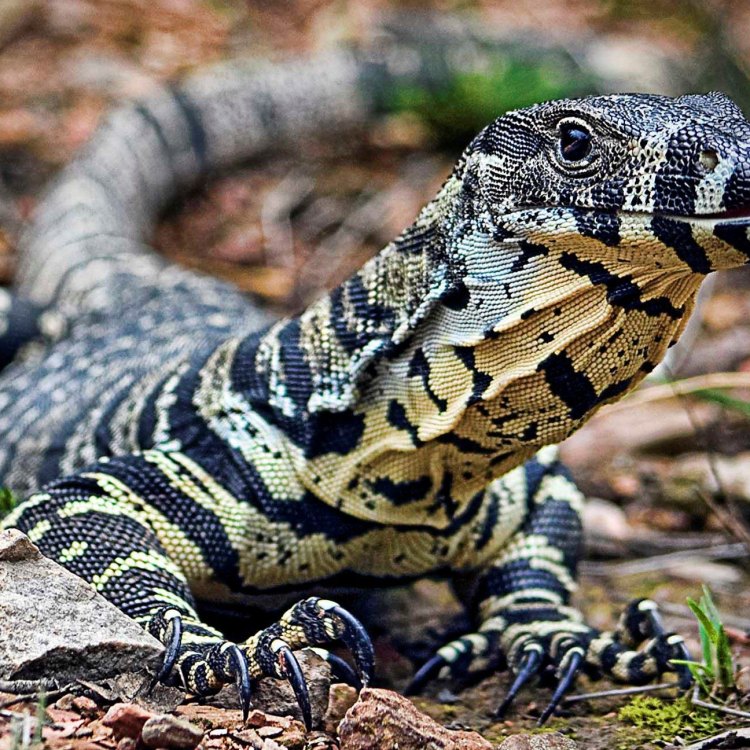
Lace Monitor
- Adult Size: Large
- Average Lifespan: 15-20 years
- Reproduction: Oviparous
- Reproductive Behavior: Females lay eggs in termite mounds or burrows
- Sound or Call: Hisses and vocalizations
- Migration Pattern: Non-migratory
- Social Groups: Solitary
- Behavior: Diurnal and arboreal
- Threats: Habitat loss, road mortality, and persecution
- Conservation Status: Least Concern
- Impact on Ecosystem: Controls populations of small mammals, reptiles, and birds
- Human Use: Not commonly used by humans
- Distinctive Features: Sturdy build, strong claws, and distinct banding pattern
- Interesting Facts: Lace monitors are excellent climbers and swimmers
- Predator: Large birds of prey, dingoes, and other monitors
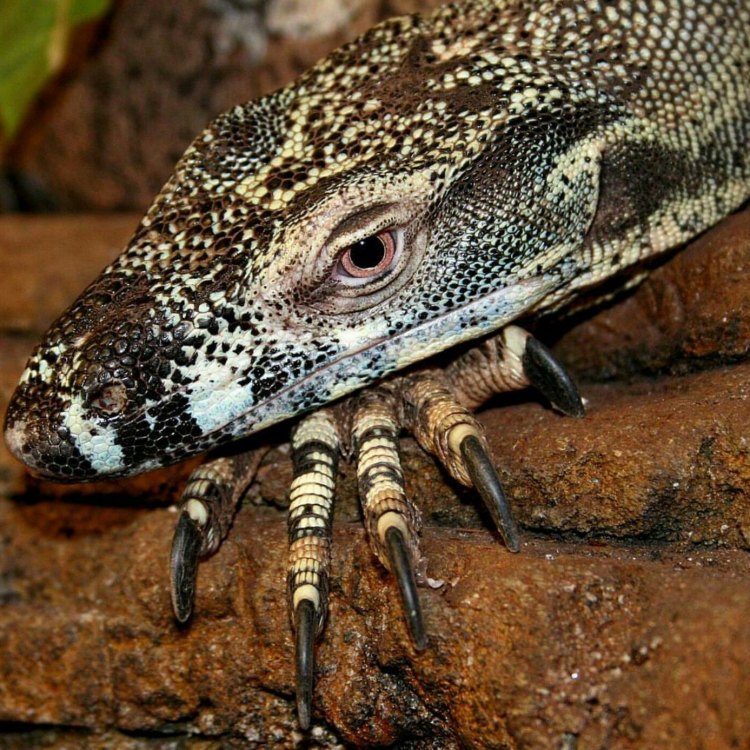
Varanus varius
The Mighty Lace Monitor: A Powerful Reptile in the Australian Ecosystem
The Australian landscapes are known for their diverse and unique wildlife, and one of the most striking creatures to call it home is the Lace Monitor (Varanus varius). This large lizard, also known as the Tree Goanna, is a formidable presence in the Australian bush. With its sturdy build, strong claws, and distinct banding pattern, the Lace Monitor is a sight to behold.But there is more to this reptile than its striking appearance PeaceOfAnimals.Com. In this article, we will delve into the world of the Lace Monitor, exploring its behavior, habitat, and impact on the ecosystem. You will discover the interesting facts about this mighty lizard and its place in Australian culture.
Size and Lifespan
The Lace Monitor is the second largest lizard in Australia, with an adult size ranging from 1.5 to 2.1 meters in length. They are generally heavier than other monitor lizards, weighing up to 20 kilograms. The females are slightly smaller than males, with an average size of 1.5 meters.In captivity, the Lace Monitors can live up to 20 years, while in the wild, they have an average lifespan of 15 to 20 years Little Brown Bat. However, in some cases, they can live up to 30 years in the wild. This impressive lifespan makes them one of the longest-living lizard species in Australia.
Reproduction and Behavior
Lace Monitors are oviparous, meaning they reproduce by laying eggs. These eggs are usually laid in termite mounds or burrows, where the females create a nest to incubate their eggs. These nests provide a warm and safe environment for the eggs to hatch.The reproductive behavior of these lizards is fascinating. Male Lace Monitors compete for female mates during the breeding season, which usually occurs between September and November. Once the female has selected her mate, she lays her eggs within a month, and the eggs hatch after an incubation period of 6 to 9 months.
Though Lace Monitors are solitary animals, they are diurnal, meaning they are active during the day. They are also arboreal, spending most of their time in trees and bushes. They are excellent climbers, using their sharp claws and strong limbs to maneuver through the branches. They are also strong swimmers and can even dive underwater for short periods.
Threats and Conservation Status
The Lace Monitor is classified as Least Concern on the IUCN Red List, meaning they are not facing any significant threats. However, like most wildlife, they do face some threats in their natural habitat. Habitat loss, road mortality, and persecution by humans are the main threats to their survival.With urbanization and land development, their habitat is getting fragmented, leaving them vulnerable to predators, such as large birds of prey, dingoes, and other monitor lizards. Road mortality is also a significant threat as these lizards often cross roads to reach other areas of their territory. Human persecution is also a concern, as they are sometimes killed due to fear and misunderstanding of their behavior.
To ensure the survival of Lace Monitors, conservation efforts are focused on educating people about their importance in the ecosystem and the need to preserve their natural habitat.
Impact on the Ecosystem
Lace Monitors play a vital role in the Australian ecosystem. As apex predators, they help control the populations of small mammals, reptiles, and birds. By keeping these populations in check, they contribute to a healthier and more balanced ecosystem.Their diet is varied, consisting of insects, reptiles, small mammals, and birds. They are also known to eat eggs and carrion, making them vital in the nutrient cycle of the ecosystem. As they are also efficient climbers, they can reach prey that other predators cannot, thus ensuring a diverse diet for themselves and controlling prey populations more effectively.
Distinctive Features
The Lace Monitor has a unique appearance, making it easily recognizable. Its sturdy build and strong claws make it a powerful predator, while its distinct banding pattern helps it camouflage in its surroundings. Its body is covered in scales that protect it from predators and harsh environments.One of the most distinctive features of the Lace Monitor is its ability to change colors. Like chameleons, they can alter their skin color to regulate their body temperature or to communicate with other lizards. These color changes can vary from shades of brown to green, making them even more adaptable to their environment.
Human Use
Unlike some other monitor lizards, such as the Komodo dragon, the Lace Monitor is not commonly used by humans. However, in the past, they were hunted for their meat and eggs by Indigenous Australians. In modern times, they are occasionally kept as pets, but this practice is not very common due to their large size and specialized care requirements.On the other hand, the Lace Monitor holds a special place in Australian culture. It is often depicted in indigenous art and is considered an important animal in Aboriginal mythology. Its distinct banding pattern is also used in traditional designs and is a popular symbol in Australian jewelry and accessories.
Interesting Facts
Apart from their distinctive features, there are numerous interesting facts about the Lace Monitor. Here are a few that will pique your curiosity:- The Lace Monitor is one of the few lizard species that hibernates during winter.
- They have a strong sense of smell, which helps them locate food and sense danger.
- They are known to make hissing sounds and vocalizations to communicate with other lizards and warn predators of their presence.
- Younger Lace Monitors are prey for larger predators, which is why they develop their climbing and swimming skills at a young age to improve their survival chances.
- Their sharp claws and powerful bite make them formidable predators, but they are also known to use their tail as a weapon for defense.
With its impressive size, unique appearance, and important role in the Australian ecosystem, the Lace Monitor is a truly fascinating creature. Though it may not be commonly used by humans, its presence alone serves as a reminder of the rich and diverse wildlife that inhabits the Australian landscapes.
So next time you are out exploring the Australian bush, keep an eye out for the mighty Lace Monitor, and you might just catch a glimpse of this impressive reptile in its natural habitat.
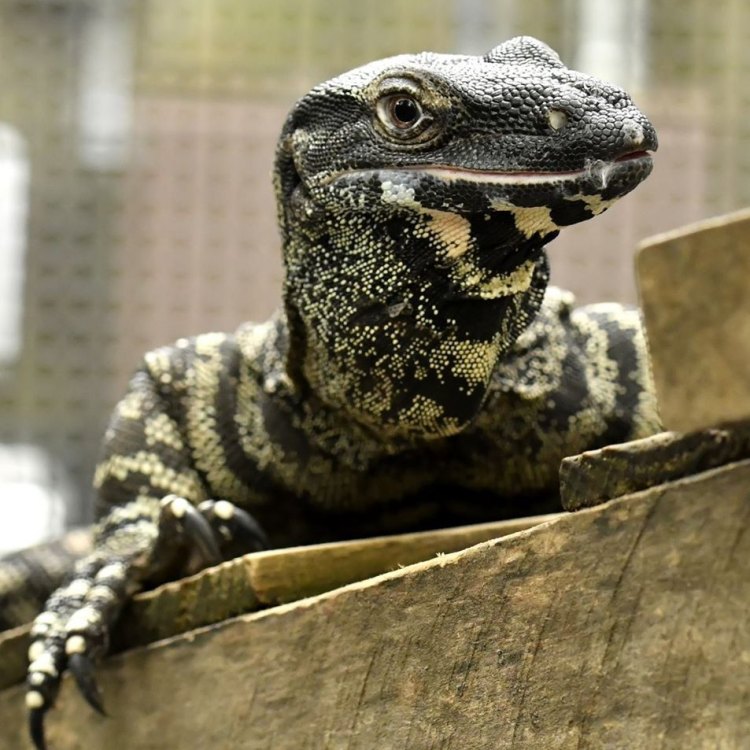
The Misunderstood Lace Monitor: Exploring the Fascinating Life of Varanus varius
Disclaimer: The content provided is for informational purposes only. We cannot guarantee the accuracy of the information on this page 100%. All information provided here may change without prior notice.


